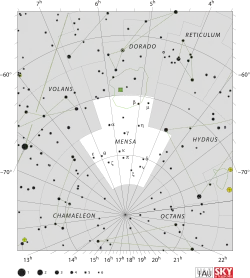 | |
| Observation data Epoch J2000.0 Equinox J2000.0 (ICRS) | |
|---|---|
| Constellation | Mensa |
| Right ascension | 05h 31m 53.01393s[1] |
| Declination | −76° 20′ 27.4779″[1] |
| Apparent magnitude (V) | 5.19[2] |
| Characteristics | |
| Spectral type | K2 III[3][4] |
| U−B color index | +1.18[2] |
| B−V color index | +1.13[2] |
| Astrometry | |
| Radial velocity (Rv) | +56.7±0.8[5] km/s |
| Proper motion (μ) | RA: +140.646[6] mas/yr Dec.: +269.634[6] mas/yr |
| Parallax (π) | 31.1021 ± 0.1519 mas[6] |
| Distance | 104.9 ± 0.5 ly (32.2 ± 0.2 pc) |
| Absolute magnitude (MV) | +2.70[7] |
| Orbit[8] | |
| Period (P) | 7.455±4.857 yr |
| Semi-major axis (a) | 51±10″ |
| Eccentricity (e) | 0.59±0.15 |
| Inclination (i) | 53±8° |
| Longitude of the node (Ω) | 117±90° |
| Periastron epoch (T) | 1995.111±4.085 |
| Argument of periastron (ω) (secondary) | 124±74° |
| Details[9] | |
| γ Men A | |
| Mass | 1.04 M☉ |
| Radius | 4.99 R☉ |
| Luminosity | 21 L☉ |
| Surface gravity (log g) | 2.76[3] cgs |
| Temperature | 4,491[3] K |
| Metallicity [Fe/H] | +0.22 dex |
| Age | 10.60 Gyr |
| Other designations | |
| Database references | |
| SIMBAD | data |
Gamma Mensae, Latinized from γ Mensae, is an orange-hued star system in the southern constellation of Mensa. The apparent visual magnitude of 5.19[2] indicates it is dimly visible to the naked eye. Based upon an annual parallax shift of 7.70 mas as seen from the Earth,[1] it is about 102 light years from the Sun. At that distance, the visual magnitude is diminished by an extinction factor of 0.033 due to interstellar dust.[9] The system shows the high velocity kinematic properties of a population II star, but has Sun-like abundances of most elements.[11]
This is a probable astrometric binary system[4] with poorly constrained orbital elements. The visible member, component A, is an evolved K-type giant star with a stellar classification K2 III[3] At about 10.6 billion years of age, it has nearly the same mass as the Sun but has expanded to five times the Sun's radius.[9] The star shines with 21 times the Sun's luminosity from its enlarged photosphere at an effective temperature of 4,491 K.[3]
References
- 1 2 3 van Leeuwen, F. (2007), "Validation of the new Hipparcos reduction", Astronomy and Astrophysics, 474 (2): 653–664, arXiv:0708.1752, Bibcode:2007A&A...474..653V, doi:10.1051/0004-6361:20078357, S2CID 18759600.
- 1 2 3 4 Johnson, H. L.; et al. (1966), "UBVRIJKL photometry of the bright stars", Communications of the Lunar and Planetary Laboratory, 4 (99): 99, Bibcode:1966CoLPL...4...99J.
- 1 2 3 4 5 Gray, R. O.; et al. (July 2006), "Contributions to the Nearby Stars (NStars) Project: spectroscopy of stars earlier than M0 within 40 pc-The Southern Sample", The Astronomical Journal, 132 (1): 161–170, arXiv:astro-ph/0603770, Bibcode:2006AJ....132..161G, doi:10.1086/504637, S2CID 119476992.
- 1 2 Eggleton, P. P.; Tokovinin, A. A. (September 2008), "A catalogue of multiplicity among bright stellar systems", Monthly Notices of the Royal Astronomical Society, 389 (2): 869–879, arXiv:0806.2878, Bibcode:2008MNRAS.389..869E, doi:10.1111/j.1365-2966.2008.13596.x, S2CID 14878976.
- ↑ de Bruijne, J. H. J.; Eilers, A.-C. (October 2012), "Radial velocities for the HIPPARCOS-Gaia Hundred-Thousand-Proper-Motion project", Astronomy & Astrophysics, 546: 14, arXiv:1208.3048, Bibcode:2012A&A...546A..61D, doi:10.1051/0004-6361/201219219, S2CID 59451347, A61.
- 1 2 3 Brown, A. G. A.; et al. (Gaia collaboration) (August 2018). "Gaia Data Release 2: Summary of the contents and survey properties". Astronomy & Astrophysics. 616. A1. arXiv:1804.09365. Bibcode:2018A&A...616A...1G. doi:10.1051/0004-6361/201833051.
- ↑ Anderson, E.; Francis, Ch. (2012), "XHIP: An extended hipparcos compilation", Astronomy Letters, 38 (5): 331, arXiv:1108.4971, Bibcode:2012AstL...38..331A, doi:10.1134/S1063773712050015, S2CID 119257644.
- ↑ Hartkopf, W. I.; et al. (June 30, 2006), Sixth Catalog of Orbits of Visual Binary Stars, United States Naval Observatory, archived from the original on 2017-08-01, retrieved 2017-06-02.
- 1 2 3 Wittenmyer, Robert A.; Liu, Fan; Wang, Liang; Casagrande, Luca; Johnson, John Asher; Tinney, C. G. (July 2016), "The Pan-Pacific Planet Search. V. Fundamental Parameters for 164 Evolved Stars", The Astronomical Journal, 152 (1): 15, arXiv:1605.00323, Bibcode:2016AJ....152...19W, doi:10.3847/0004-6256/152/1/19, S2CID 55991800, 19.
- ↑ "gam Men". SIMBAD. Centre de données astronomiques de Strasbourg. Retrieved 2017-08-16.
{{cite web}}: CS1 maint: postscript (link) - ↑ Foy, R. (May 1980), "Detailed analysis of high velocity stars", Astronomy and Astrophysics, 85 (3): 287–294, Bibcode:1980A&A....85..287F.